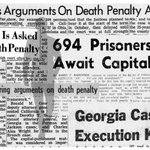
Furman v. Georgia was one of the most monumental cases in American legal history: the 1972 decision overturned every state death penalty statute in the country and spared the lives of nearly six hundred people sentenced to die. But the lead petitioner, William Henry Furman, was little aware of his impact. Poor, Black, mentally ill, and physically and intellectually disabled, he was sentenced to death for the killing of a homeowner during a botched robbery, which he maintains was accidental. “If…petitioner Furman or his crime illustrates the ‘extreme,’ then nearly all murderers and their murders are also ‘extreme,’” wrote Justice William Brennan in the decision. Now elderly, Mr. Furman lives quietly in Georgia and continues to oppose the death penalty.
Before the night of August 11, 1967, 24-year-old Mr. Furman had been living with his mother and working construction. With only a sixth-grade education, and suffering from bouts of psychosis brought on by epilepsy, he struggled to make ends meet amidst a growing dependency on alcohol. He had a string of convictions for petty crimes and says he was known as the “Bungling Burglar.” He broke into the home of William Micke after a day of heavy drinking hoping only “to pick up a radio or two.” But Mr. Micke heard a noise and woke up. Mr. Furman fired a gun through a closed door as he fled, killing Mr. Micke with one shot. According to Mr. Furman, the gun went off when he tripped on a wire from the washing machine, and he had no idea he had hit anyone.
Police followed a set of tracks and found Mr. Furman hiding under his uncle’s porch with the gun in his pocket within minutes of the death. Mr. Furman confessed to breaking into the home and firing his weapon, but as David Oshinsky wrote in his book chronicling the history of the case, Mr. Furman “seemed stunned to learn that the homeowner was dead.” The state charged Mr. Furman with felony murder and sought the death penalty. The court then appointed local lawyer B. Clarence Mayfield to represent Mr. Furman for $150 — a stroke of luck which eventually brought the case to the attention of prominent abolitionists looking for a vehicle to challenge the death penalty at the Supreme Court.
Mr. Mayfield was one of the only Black attorneys in Savannah and was closely involved with the Civil Rights Movement. According to Mr. Oshinsky, Mr. Mayfield viewed the death penalty “as a punishment reserved for society’s outcasts, especially poor blacks” like Mr. Furman. Mr. Mayfield entered a plea of insanity and had Mr. Furman medically evaluated before trial; a panel of doctors at Georgia Central State Hospital unanimously agreed on a diagnosis of “mental deficiency, mild to moderate, with psychotic episodes associated with convulsive disorder [epilepsy].” They found that Mr. Furman was “not capable of cooperating with his counsel in the preparation of his defense” and recommended further psychiatric hospitalization. Despite these findings, the court judged Mr. Furman competent to stand trial.
Mr. Mayfield called Mr. Furman to testify at trial and explain that the shooting was an accident and he “didn’t intend to kill nobody,” but was not surprised when the jury returned a finding of guilty and a sentence of death the same day. With a jury of 11 whites and one Black in 1960s Georgia, Mr. Mayfield saw the outcome as nearly inevitable. However, he raised awareness of the case with his civil rights colleagues, which led to Mr. Furman’s appeal eventually being selected by the NAACP Legal Defense Fund (LDF) in their constitutional challenge to capital punishment.
“It was black on white. A black man killed a white man. That did it. A white judge, a white jury — they wouldn’t need to know anything else when they heard black on white. The black man was done for.”
Though Mr. Furman had been judged competent at trial, the state sent him back to Georgia Central State Hospital after his trial instead of to death row, in an apparent acknowledgement of his serious mental impairments. He was there on January 17, 1972 when LDF lawyer Anthony Amsterdam argued on his behalf at the Supreme Court that death sentences were inflicted on the “predominantly poor, Black, personally ugly, and socially unacceptable.” Mr. Furman remembers watching reporters arrive through the bars on his window at the hospital six months later on June 29, the morning the decision in Furman v. Georgia was announced. Mr. Mayfield also drove to the hospital to deliver the news to Mr. Furman directly. However, Mr. Oshinsky writes, Mr. Furman “stared blankly at his lawyer, unable to recognize him, much less understand the legal history they had made.”
Mr. Furman was released on parole in 1984 and struggled to land on his feet. He sporadically worked construction and went through periods of homelessness, taking shelter in cars and abandoned houses. Legal journalist Joan Cheever tracked Mr. Furman down in the late 1990s as part of her project investigating the outcomes of the “Class of ‘72” — the people who had their death sentences overturned as a result of Mr. Furman’s case. After looking for Mr. Furman for 13 years, she found him living in Atlanta in a duplex, in poor health but, as she described it, a strong zeal to live.
“At 56, Furman is in bad shape, physically and mentally. He seems slow. He doesn’t know his own telephone number and has to bring me the phone book, on which his number has been scribbled in pencil. He has trouble with his eyes. I don’t know if he can write.”
Mr. Furman told her that he’d had two heart attacks since his release, experienced difficulty breathing, could not walk for long periods, and had to quit construction work. However, he had also quit drinking, and he spent his time volunteering at a Methodist soup kitchen and collecting aluminum cans. He had never married and had no children. “It’s still rough on me,” he told Ms. Cheever of his experience. “I think about it a lot. Once or twice I thought I would be executed. I came close to death. I try to put it in the back of my mind. I think to myself — I’m here. I have more time.”
In 2006, Mr. Furman was sent back to prison for burglary. He was released in 2016. Reuters reported at the time of his release that Mr. Furman “wants to share his experiences with young people, counseling them to avoid the alcoholism and petty theft” that led to the events of August 11, 1967. “I still believe the death penalty is cruel and unusual punishment,” Mr. Furman said.
Ms. Cheever once asked him how he felt about his “contribution to the abolition of the death penalty.” He seemed startled, she wrote. She repeated: “Mr. Furman, your case is the one responsible for saving the lives of 588 people on death row. How do you feel?” He shrugged. “I didn’t do nothing back then but try to stay alive. I just wanted…to stay alive.”
David Beasley, Georgia inmate in historic death penalty case gains perspective, Reuters, April 27, 2016; David M. Oshinsky, Capital Punishment on Trial: Furman v. Georgia and the Death Penalty in Modern America (2010); Joan M. Cheever, The men who escaped their fate on Death Row, The Independent, April 29, 2006.



